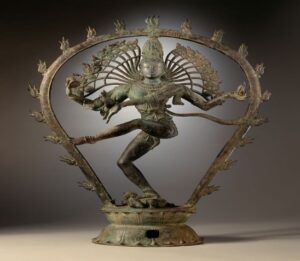Published on: December 16, 2022
Nataraja idol
Nataraja idol
Why in news? The Idol Wing CID (IWCID) of the Tamil Nadu police successfully stopped the scheduled auctioning of a bronze idol of Nataraja by Christies.com, France. The rare variety bronze idol was suspected to have been stolen from Kayathar in Thoothukudi district half a century ago.
Highlights
- The bronze idol belongs to the Vijayanagara period 15th-16th century.
- It bore resemblance to the idol of Nataraja an image taken in 1958 by the French Institute of Pondicherry (IFP)
- The IFP image of the Nataraja idol was taken in 1958 in Kothanda Rameshwara Temple, Kayathar, Kovilpatti, now in Thoothukudi district (earlier in composite Tirunelveli district).
- It is now insisted that the idol should be returned to India as have adequately established the ownership as required under the UNESCO Convention of 1970,
Nataraja
- Also known as Adalvallaan
- It is a depiction of the Hindu god Shiva as the divine cosmic dancer.
- Dance is called
- Nataraja is considered one of the highest forms of Shiva in Tamil Nadu, and thus sculpture or Bronze idol of Nataraja is kept and worshiped in all Shiva temples across Tamil Nadu
- It typically shows dancing in one of the Natya Shastra poses, holding various symbols trampling upon a demon shown as a dwarf (Apasmara or Muyalaka), symbolizes spiritual ignorance
Meaning of the idol
- Dances within a circular or cyclically closed arch of flames (prabha mandala): Existence of Cycle of life
- Looks calm( Continuous chain of creation and destruction ):supreme tranquility of the Atma
- Legs are bent: Suggests an energetic dance
- Flying strands of his hair , is typically the river Ganges personified as a goddess: Danger of a mighty river is creatively tied to a calm river for the regeneration of life.
- Damaru: It symbolizes rhythm and time.
- Upper left hand contains Agni or fire: Signifies forces of creation and destruction
- Abhaya mudra (meaning fearlessness in Sanskrit): Suggesting not to fear nearby evil
- Two eyes plus a slightly open third on the forehead: Inner eye, or symbol of knowledge (jnana), urging the viewer to seek the inner wisdom, self-realization.

